Analyzing Intel Core M Performance: How 5Y10 can beat 5Y71 & the OEMs' Dilemma
by Brett Howse & Ian Cutress on April 8, 2015 8:00 AM ESTCinebench R15 Multi-Threaded Results
Looking at a multi-threaded run of Cinebench, the devices which will perform the best are going to need to have enough thermal headroom to keep all of the cores working at a good pace. All of these devices have four logical cores mapped to two physical cores via Hyperthreading, all of which are run at maximum load for the duration of this test.
The Core i5 once again has no issues maintaining its high CPU frequency, even though the overall SoC temperature does get higher than the single-threaded run. The Dell Venue 11 Pro tablet though starts off really reaching for the stars, but quickly must throttle back until it finds a consistent range that allows it to stay within its cooling constraints. The Yoga 3 Pro is similar, but quickly falls back due to the 65°C limit placed on the processor by the manufacturer. The ASUS UX305 performs just as well in this test as the last, with a very consistent CPU frequency, despite the temperatures getting a bit higher than the last run.
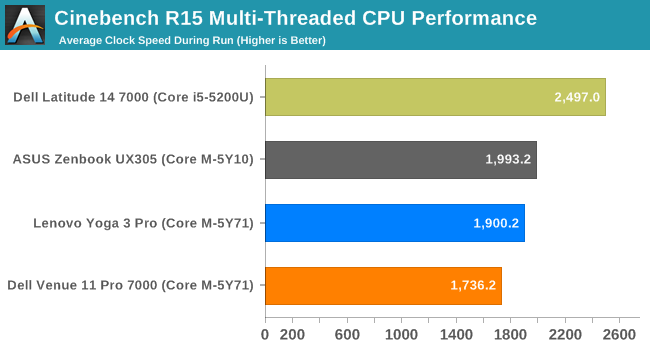
When it comes to average CPU frequency, both the Lenovo Yoga 3 Pro and the Dell Venue 11 Pro once again end up falling behind the ASUS and its much lower turbo speed in this test, though not by a huge margin. The ASUS averages the highest CPU frequency of the Core M contenders just like in the single-threaded workload, with the Lenovo less than 100MHz behind it, and the Dell Venue a ways back again. Neither of the 5Y71 devices turbo much over the 5Y10 in this test though.
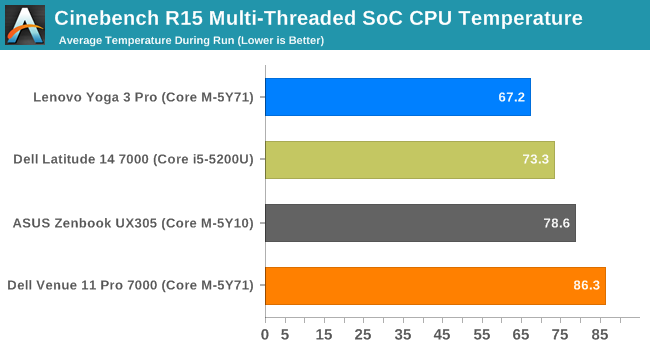
Looking at the temperatures, you can see just how conservative Lenovo has been with the Yoga 3 Pro. The overall SoC temperature is quite a bit lower than all of the other devices when the device is under load. The active cooling and low SoC temperatures help the Yoga 3 Pro to keep a cool exterior to the device.
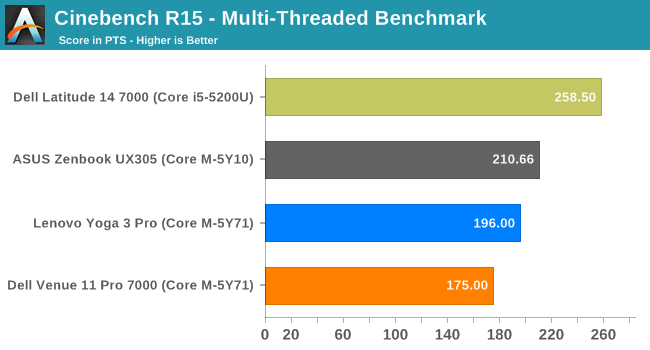
Now we come to the end result of this workload. The 5Y10 device handily outperforms both of the higher ranked models. Unsurprisingly it comes no where near the Core i5, but looking at the CPU frequency graph really demonstrates why it scores higher. Both of the 5Y71 have a lower average score, but unlike the single-threaded result, neither of them can sustain a CPU frequency past the frequency of the ASUS very much.


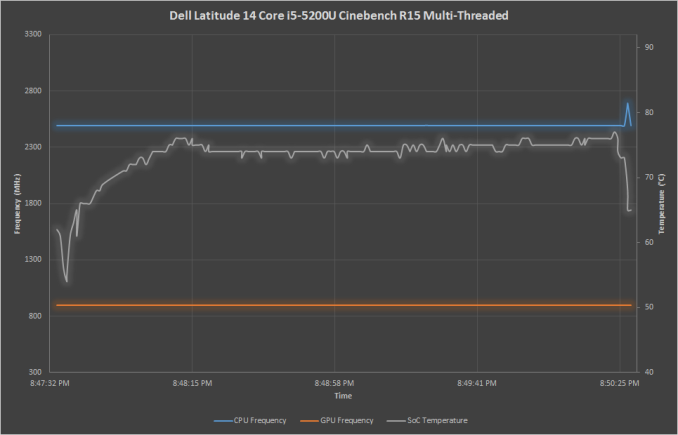
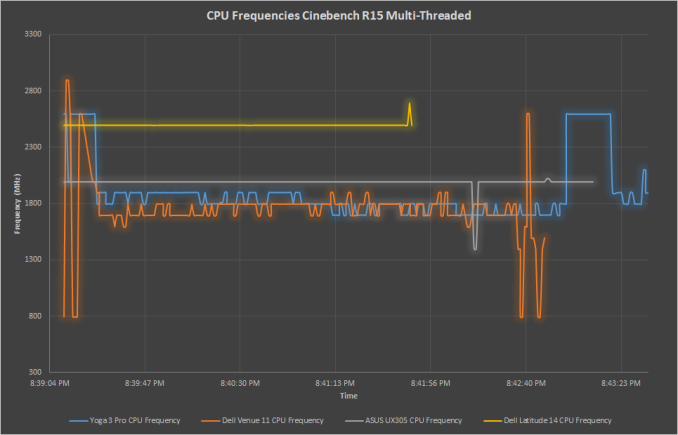
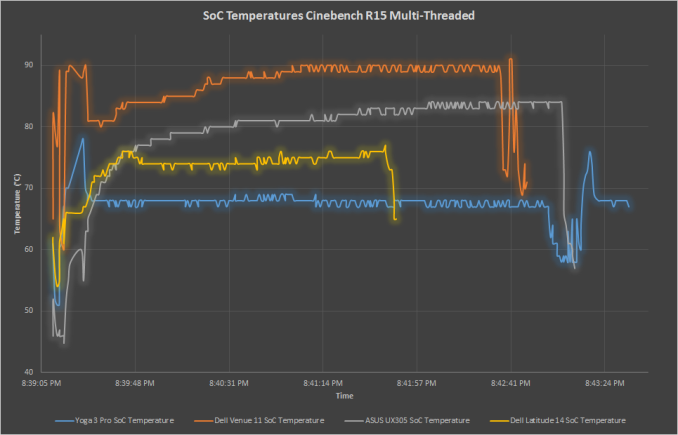








110 Comments
View All Comments
serendip - Wednesday, April 8, 2015 - link
Core M is expensive for what it does. If you want mobility without a fan, go with Atom. If you want better unthrottled performance, go with the U models.It's the weird throttling and poor OEM thermal designs which concern me. Core M may have good turbo speeds but that's useless if it has to throttle down quickly from heat soak. Users will be disappointed when their machines act speedy one moment and start lagging the next, no matter what the design turbo speeds are.
serendip - Wednesday, April 8, 2015 - link
Can't edit comments, sigh. Anyway, my Bay Trail Atom tablet runs from 600 MHz to 1.86 GHz and has no issues with thermal throttling. It can smoothly turbo and then clock down without dropping down too far and sacrificing usability.It seems some OEMs like Lenovo set a total system power draw limit that's too low, on top of skin thermal limits. The CPU can only turbo for very short periods of time before being dropped to base speed or even lower. You're then stuck with a 1 GHz CPU and 100 MHz GPU which you paid a ton of money for. I think the problem lies with both sloppy engineering from OEMs and unrealistic promises made by Intel.
nonoverclock - Wednesday, April 8, 2015 - link
I have a Bay Trail Atom (Venue Pro 11) and it's alright but I definitely need more speed. Trying to stream sports games through their Metro apps will often skip and this doesn't happen on my higher performance devices. Also it has some inexplicable pauses here and there. More speed would be great.Brett Howse - Wednesday, April 8, 2015 - link
I think you are missing the fact that even throttled Broadwell is a lot faster than Silvermont cores. I don't have the T100 in the notebook bench (it is a tablet) but the HP Stream has two Silvermont cores and a 7.5 watt TDP http://anandtech.com/bench/product/1449?vs=1400If you want to compare to quad-core Bay Trail some of the scores are here http://anandtech.com/show/7428/asus-transformer-bo...
Bay Trail was a big boost for Atom but I would take Core M in a mobile device over it any day.
Pissedoffyouth - Thursday, April 9, 2015 - link
My bay trail Asus T100 never throttles back from 1.8ghz even under prime95+furmark. very power efficientsonicmerlin - Wednesday, April 8, 2015 - link
I really like this article, but I wish you had run GFXBench, which is more of a pure GPU test. I want to compare the results to the iPad's A8X and Tegra K1.Brett Howse - Wednesday, April 8, 2015 - link
I have discussed this in the actual device reviews. This article wasn't about that kind of comparison so I will ask you to go to the review http://anandtech.com/show/9104/asus-zenbook-ux305-...testbug00 - Wednesday, April 8, 2015 - link
All this testing, and, I don't see a single power system power draw number for anything. Maybe I'm missing something? But, woudn't seeing the i5 system draw 7-13 watts more be useful for determining how good Core M is?If the product uses a third of the power and gets 50-100% of the performance... Well. That's very impressive.
Alexvrb - Wednesday, April 8, 2015 - link
Do you like phystics? Do you like phystics in your mouth? (typo on page 2!)Brett Howse - Thursday, April 9, 2015 - link
TYVM :)